COVER- The Tao of poo: Can Worrell's green sewage system save water and planet?
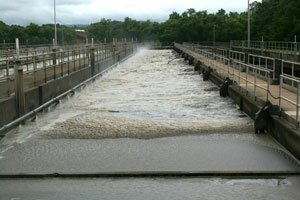
Since 2003, around 100 million gallons of untreated sewage have flowed from this RWSA facility into Moore's Creek, a tributary of the Rivanna River. Local water users and state taxpayers will split the cost of the $40.3-million upgrade.
PHOTO BY DAVE MCNAIR
On May 27, Governor Tim Kaine (D) presided over the groundbreaking ceremony for a $40.3 million upgrade of the Moore's Creek Wastewater Treatment Plant, which one attending official called the "next step in addressing the impact of humans on the natural ecology."
Of course, it's a welcome upgrade, but is it really the "next step"? What if there were a company right here in Charlottesville that makes a waste treatment system designed to look like a beautiful garden and mimic a tidal estuary, a system that purifies wastewater without chemicals, emits no odors, and comes at a fraction of the price of systems like Moore's Creek?
Too good to be true? Let's find out
***
During a 1970s trip to Africa, former Daily Progress owner Tom Worrell, 63, says he had an epiphany. But it wasn't about the family business, the newspaper empire that his father, Gene Worrell, had recently transferred over to him.
"I thought I was a sort of 'master of the universe'," says Worrell, "but I really didn't know anything."
Hot and thirsty under the equatorial sun, Worrell says he came to a river near a small village, and when he bent down to dip his hand, he heard a man behind him say, "Don't touch the water, it will kill you."
"I was a different person after that trip to Africa," says Worrell, who found himself alarmed by the scarcity and poor quality of the water. "I knew I had to do something."
In the mid-'80s at his Charlottesville-area farm, Worrell was entertaining ecologist and inventor John Todd, a man trying to develop "living machines," systems to purify contaminated water by replicating processes found in nature.
"John was a good friend, he thought of these wonderful things, but could never make them work," says Worrell. "He said to me, 'How would you like to invest in a sewage treatment facility made of plants? At that time," Worrell laughs, "I told him, ' I think I'll pass."
Years later, however, as Todd began to refine his devices (Time magazine named Todd a "Hero of the Planet" in 1999), Worrell says he began to take a more serious interest in the technology.
Twenty years after that African epiphany, Worrell finally got his chance to tackle the world's water woes.
In 1995, Worrell sold the media company that his father had started 46 years earlier with the purchase of the the Bristol Virginia-Tennessean. Buyer Media General Inc. paid $230 million in cash for the Daily Progress and 28 other publications, leaving the now ex-media mogul free to fund his passions.
In 1999, Worrell would take over Todd's business and register The Living Machine as a trademark of a new company, Worrell Water Technologies. The firm, with offices located in Charlottesville, has already installed over a dozen Living Machines across the country, in addition to one in the African coastal nation of Ghana and in the tiny European Netherlands.
In additions to giving buyers a way to organically process 2,500 to 200,000 gallons of waste water a day, the company has also provided Worrell with a soap box. His publicity materials assert that water is the world's next big crisis and that centralized public water and wastewater treatment systems "simply can not handle water demand in the midst of our dwindling water supply."
"We'll be fighting the next wars over water," he says in a recent interview.
He mentions the list of contaminants already found in drinking water, which is indeed long and frightening to read, most of which are caused by sewage and industrial runoff, as well as by the chemicals commonly used to disinfect municipal water systems. For example, trihalomethanes (THMs), a byproduct of water chlorination, has been shown to cause an increased risk of cancer.
Worrell also mentions something the Environmental Protection Agency is just beginning to study– water contamination through sewer systems– caused by the release of the many pharmaceuticals humans ingest or discard.
Last year, the Associated Press, tracking 24 major municipal water systems, revealed that traces of medicines used to treat high cholesterol, allergies, high blood pressure, bipolar disorder, and depression. Though the diluted drugs may not be cause for immediate alarm, the EPA agreed to test 150 other locations across the country and study the long-term effect of consuming micro-doses of medicines.
"Our ground water," says Worrell, "is worse than we think it is."
So, what is a Living Machine?
The Living Machine is a man-made, turbo-charged tidal wetland. But whereas the earth only has two tidal cycles a day, the Living Machine has 10 to 12 of them. Basically, waste water is pumped and filtered, and monitored by microcomputers, through a series of cells that use plants in porous gravel to cultivate natural microorganisms that eat up the waste. The cells continuously fill and drain, replicating and accelerating the tidal action found in estuaries, according to William Kirksey, the company's senior vice president.
"We've used technology to replace nature," says Kirksey, referring to traditional waste treatment plants, "but now we can use technology to re-create nature, and bring that back to balance."
"It's based on how the earth works," says Worrell, "and when it comes to a solution for fixing our water problems, I put my money on the earth."
In Guilford County, North Carolina, school officials thought enough of the Living Machine to put their money on Worrell.
In 2006, faced with with the prospect of spending $5 million to connect to a municipal sewer system, Guilford officials opted instead for a Living Machine as part of a $42 million project to build a new "green" middle and high school. The treatment system processes 30,000 gallons of waste water a day, producing enough water to irrigate three athletic fields and refill toilets. Total cost: $500,000.
Besides costing just a tenth of the cost of connecting to the County sewer system, Guilford's half-acre Living Machine provides enough water that the schools have "the greenest athletic fields around, even in a drought." However, it must be monitored, both by local sewer authority officials and the local health department, at a cost Guilford estimates at around $78,000 a year.
Comparatively, Albemarle County pays $22,104 a year to maintain a sewage treatment system at Stone-Robinson Elementary School. Albemarle's only on-school waste facility is an in-ground activated sludge plant built in 1987 that handles 7,000 gallons of waste a day. Presumably, if the facility had to handle four-times as much waste water, costs might compare to maintaining a Living Machine.
Unlike the Guilford system, however, Stone-Robinson doesn't use the resulting water. Instead, the treated water is flushed into the Rivanna River, a process that drops organic solids, chlorine, and bacteria into the waterway– and requires re-permitting every five years from the Virginia Department of Environmental Quality.
According to Lindsay Check-Snoddy, environmental compliance manager for county schools, the Stone-Robinson system performs well in "limiting" the amount of contaminants that enter the Rivanna.
Scott Greene, an environmentalist with the Guilford County Health Department, says the Living Machine system has "performed really well, but that's because we have a fantastic operator who monitors it five days a week."
Because the Living Machine is exposed to the elements, rain, lighting, cold, and heat are always a threat. Lighting has taken out valves and pipes in the system, Greene says, and cold weather has depleted the food supply for the bacteria. Conversely, hot weather has overburdened bacteria with food, and the threat of heavy rain is of particular concern.
"Our operator is really good at watching the weather," says Greene. "When it rains, he has to let water out of the tidal land so it won't overflow. Without him there, we'd have a big problem."
Central Virginia officials knows something about overflows. The Hook obtained several years of state data that show that in just seven months of 2003, 65 million gallons of untreated sewage flowed into Moore's Creek from the Rivanna Water & Sewer Authority's plant. Things were better in 2004 and 2005 when fewer than five million gallons of sewage bypassed the system. But in a single October 2006 incident, 24.55 million gallons of human, household, and corporate slop poured into Moore's Creek.
The official blame for all these permit-exceeding incidents went to "heavy rains." But what if the system itself is flawed?
Guilford's Greene admits some folks expressed skepticism about having a half-acre "sewage field" near a school, but he says it's now seen as a community-embraced model that wins visits from all over North Carolina.
Unlike conventional sewage treatment facilities and septic tanks, which typically consist of a swirling, stenching vat of brown water, Living Machines have actually been described as beautiful, either by blending into the landscape or when professionally landscaped with sculptures and rock formations to look like botanical gardens.
But shouldn't an open-air treatment facility start to, well, stink?
"There's no exposed water surface," says Kirksey. "Unlike traditional treatment plants, which can cause oder problems, it's all below ground, so no odors come out of it."
Kirksey says the draining and filling is all kept under the surface of a very tightly packed gravel mixture. When the cell fills, carbohydrates and ammonia in the wastewater attach to the gravel and biofilms, and bacteria destroy the odor as they consume the waste.
Indeed, because the Guilford system has to serve two schools, Greene is particularly impressed by its lack of odor. "It has to handle alot of ammonia," he says, pointing out that kids tend to urinate at school far more than they defecate.
Here in Charlottesville, residents don't have to be told about the stink that can come from a traditional treatment plant.
For years, folks in the Woolen Mills neighborhood have complained about smells from the Moore's Creek Wastewater Treatment Plant, with some calling it "intolerable."
In late April, the Rivanna Solid Waste Authority authorized a construction contract for $40.3 million (with $21.6 million coming from a state grant to help reduce Chesapeake Bay pollution) to overhaul the facility to reduce odor and nutrient pollution. The 42-month construction project had its ceremonial ground-breaking May 27, and Charlottesville Tomorrow pronounced the facility "innovative."
Worrell, however, seems to be suggesting, however, that a field of plants atop some subterranean pumps and valves would work as well.
In fact, for a new installation in Portland, Oregon, over half the system will be located in the lobby of an upscale office building. The Living Machine planned for the under-construction 10-story headquarters for the Port of Portland, the entity that runs Portland International Airport, will recycle the building's water from sinks, showers, and toilets for reuse in the toilets– while helping the structure use just 20 percent of the water used by a conventional office building.
"It will look like a little marsh or garden," says Kirksey. "And visitors won't notice any odors."
Okay, it's odorless, so does that mean–dare we say– that it's drinkable too? If Guilford can use recycled water on athletic fields, why can't it be re-used in drinking fountains? After all, astronauts aboard the International Space Station are now drinking water recycled from their urine.
Kirksey says a simple disinfection step is required to make water from the Living Machine of drinkable quality, a step that is already taken with a system that serves a dog kennel in Las Vegas.
"The water in a situation like that must be clean enough to allow for the possibility of human ingestion and to prevent disease transmission," says Kirksey.
But he believes water may have to become pretty scarce (remember, the astronauts are 200 miles away, straight up, from any water source) before folks embrace the idea of drinking recycled sewage– no wastewater treatment systems in the U.S. have ever been permitted to provide potable water.
"Even though the water is of drinkable quality," says Kirksey, "we can't legally call it drinking water or recommend that anyone drink it."
Sludge Match
As with Guilford, the Living Machine also serves as a classroom of sorts at the private Old Trail School in Northern Ohio's Cuyahoga Valley National Park. There, a portion of the system was installed inside a greenhouse classroom so that students could study ecology while simultaneously treating 5,000 gallons of the school's wastewater.
Perhaps the most powerful endorsement for the Living Machine comes from the famed Esalen Institute on the Big Sur coastline of Northern California, one of the world's best known alternative think tanks, and a retreat for exploring what Aldous Huxley, one of the early founders, called the "human potential."
In 2007, Esalen chose a Living Machine to process flows from laundry and lodging facilities and to support the upgade of its existing waste water treatment system.
At the Sidwell Friend's School in Washington DC however, the school the new First Family chose for their daughters, green designers decided against installing a Living Machine. Instead, the school installed a more simple tank-based "constructed wetland." Unlike the Living Machine, the chosen natural system has fewer pumps, costs much less, and does not require as much monitoring.
For purists in the ecological design movement, the Living Machine's abundance of technology is a negative. In fact, Todd's son, Jonathan, who worked for Worrell for a time when he took over his father's company, says he eventually left with his father to start their own constructed wetlands company, John Todd Ecological Design. They build Eco-Machines, which have fewer "moving parts," according to the younger Todd.
"There's no staff required to run it, just a once a month check and test by a licensed operator," says architect Bill Reed, a consultant on the Sidwell Friends project. "The only real positive in this case would have been instructional, as one can see more things going on in the Living Machine."
Jonathan Todd concedes there is plenty of room for different companies in a field that has been evolving "at break-neck speed."
"It has slowed down a bit since the economy went bad," says Todd. "But ecological wastewater treatment is going to be one of the fastest growing waste water technologies."
Still, it's clear that Todd sees Worrell's Living Machine as the commercialization of a technology that his father invented, and that the now-competing entrepreneurs have continued to perfect. In fact, both Worrell and Todd admit to some legal wrangling over the ownership of the Living Machine name.
For his part, Worrell is quick to aknowledge Todd's role, but as Kirksey points out, there is one big difference between other constructed wetlands and the Living Machine: sewage sludge, the smelly, often-toxic residue left over from treated waste water that settles in holding tanks.
"Yes, there's sludge," says Reed. "About every three to fifteen years it will have to be removed."
At Albemarle's Stone-Robinson, for example, about three-quarters of a dry metric ton of sludge, politely dubbed "biosolids," gets pumped out and trucked to the Moore's Creek facility every year, for re-treatment and recycling as fertilizer.
In recent years, however, concern has erupted. In a 2002 report, the Environmental Protection Agency (EPA) said that it could not assure the public that biosolids were safe. The USDA will not allow fruits and vegetables grown in biosolid-enriched soil to be certified organic.
Sludge, however, is not an issue with the Living Machine, says Kirksey, as Worrell made it a company mission to develop a system that produces none of it.
"That's what separates the Living Machine from, not only conventional, centralized systems, but from other wetland-based systems as well," says Kirksey.
What about Charlottesville?
"It could make a huge difference here," says Worrell. "For example, we could build a system for, say, the Belmont neighborhood for a couple million dollars, and you wouldn't even notice it was there."
And as the systems are scaleable, they might be sized to serve schools, neighborhoods, developments, or even single buildings and scattered around a community. They could even be built on parking lot medians or other bits of unused land.
In fact, Kirksey says a green-minded developer could theoretically own a Living Machine and charge people in the neighborhood to process waste and create re-useable water. He notes that certain Charlottesville-area developments have already stalled due to sewer capacity concerns.
Indeed, developers for Albemarle Place, a massive mixed-use development near the intersection of Route 29 and Hydraulic Road, learned– after they had begun clearing the land–- that the 1950s-era Meadow Creek interceptor, the main sewage line, was at full capacity, effectively halting the project. In 2007, the North Pointe development reportedly stalled when the developer was told that the nearby Camelot sewage treatment plant had also reached capacity.
The Rivanna Water and Sewer Authority and the Albemarle County Service Authority are each planning sewage expansions, $25.5 million for the interceptor and nearly $11 million to replace the Camelot facility.
"I think the technology should definitely be explored," says Albemarle's Check-Snoddy of the Living Machine system, "but it would probably only make sense for a location where it is cost prohibitive to tie into the existing sewer system, or where sewer infrastructure doesn't exist."
"It's difficult to get people to think about this system," says Kirksey, "because they're used to thinking about mechanical, centralized systems. Municipalities are particularly resistant."
Indeed, according to local news reports, when North Carolina state regulators learned of the Guilford project, and that waste water was going to be recycled to flush toilets, they said, "You're going to do what?!" At public meetings, Guilford officials grilled school officials for information about the cost and effectiveness of the system, and wondered why a traditional septic system wasn't considered.
However, Tom Frederick, executive director of the Rivanna Water and Sewer Authority, who has been dealing with a year's worth of controversy for choosing a new dam/pipeline over , says he's well familiar with Worrell Water Technologies.
"In fact, we have cooperated in their research by allowing them to pilot test their equipment using a small side stream flow from our facility," says Frederick.
While he says there have been no discussions about any possible sewage partnership, he adds, "If there were an opportunity where his services matched our need, we would certainly consider the opportunity."
"It's not a complete solution," Kirksey concedes, "but the Living Machine system can definitely reduce the drain on our water supply. People think of water conservation, and that's good, but re-use is important too."
One of the biggest hurdles the company faces is getting people, and communities, to even consider using fields of plants to solve water problems.
"We recycle waste," says Worrell. "Try getting a politician to talk about waste in public."
The Hook, however, did get one local politician to talk: County supervisor Dennis Rooker. As a longtime Worrell family lawyer, he's intimately familar with the new water business, but given such close ties, Rooker says he's been reluctant to press his fellow supervisors or Charlottesville City Council members about the Living Machine. But that may be changing.
Charlottesville Mayor Dave Norris, the first member of City Council to encourage the dredging of the Rivanna Reservoir before building what may turn out to be an unnecessary dam, says that Rooker has offered to introduce him to Worrell and his water company.
"My initial reaction is that it sounds very positive," says Norris, "and anything we can do to push the envelope when it comes to water conservation and reuse is worth exploring."
While Rooker supports the Moore's Creek facility upgrade, as a way to update the aging facility and aid the Cheasepeake Bay clean-up, he says that "long term, systems like the Living Machine would be a whole lot cheaper for the community."
Still, Rooker admits it would be "very difficult," as a government body, to make the transition from a centralized Moore's Creek-like facility to something like a Living Machine system, given the cost and radical thinking required.
Kirksey agrees.
"Cities will evolve over time to rely more and more on ecological wastewater treatment," he says, "but in the short run, the cost of replacing the parts of the existing infrastructure that are working would be huge."
In addition, Living Machines have never been tested on a municipal scale, and Kirksey admits that the system simply isn't designed to replace a centralized facility like Moore's Creek.
"The volume of flow treated by Moore's Creek would be impractical to treat in a densely developed area with a Living Machine," he says.
But that doesn't mean Rooker doesn't think it's a good idea.
"There's no reason we couldn't do this locally," says Rooker. "We will benefit from the enhancement of the Moore's Creek facility, but we need to look for ideas like the Living Machine, that provide less expensive and more natural options for dealing with waste. We haven't advanced our waste water treatment facilities in 100 years."
Like Kirksey, Rooker thinks the technology needs to be embraced by a "forward looking developer" who sees the benefit of the system. He mentions developments like Old Trail Village in Crozet and the planned Biscuit Run development south of town as examples of developments that could opt to go green.
Progressive architects already have a name for such places: Planned Ecological Developments (PED), and Worrell has a PED of his own. Located in Taos, New Mexico, it is a luxury resort called El Monte Sagrado.
The four-acre site, originally a complex of motel casitas built in the 1930s, includes a Living Machine, of course, but it also includes rainwater collection, geo-thermal heating and cooling systems, walls made of on-site-compressed "earth blocks," organic composting, solar power, and a host of other features that make the resort's ecosystem an intimate part of its infrastructure.
A central concept of El Monte Sagrado, however, concerns the creative management of water, a limited resource in the arid region, and something designers have taken to calling "aquatecture." For example, the resort's rainwater and springtime snow melt feed four ponds with underground piping and holding tanks linked to roof gutters.
"In the East, we've always had a lot of water, so we think it's going to be there forever," says Worrell. "It's different in the West. They know how scarce it is. They understand we are just borrowing our water."
"Water is always an intensely local issue," says Kirksey, hinting at the fierce debate that has been raging over the future of Charlottesville's 50-year water plan, "because you can't move it around the world."
Indeed, Worrell's efforts go beyond the Living Machine to include a water-filtration system he's developing that can be installed at any building's water main, and a new "secret" disinfecting chemical.
"In 2002," says Worrell, "terrorists were caught under the streets of Rome trying to inject cyanide into the water supply. So the government put out an RFP for something to combat this; our technology met their requirements."
It seems that Worrell remains haunted by that nightmare vision in African 30 years ago. Instead of the water killing him, he's determined to kill what's in the water. And foster new thinking.
"We still use a Roman-based systems for our water supplies and waste water facilities," he says. "That is a centralized system that controls everything, but people forget, that's what helped kill the Romans."
#
"We've used technology to replace nature," says William Kirksey, senior vice president at Worrell Water Technologies, referring to our municipal waste treatment plants, "but now we can use technology to re-create nature, and bring that back to balance."
PHOTO BY JEN FARIELLO
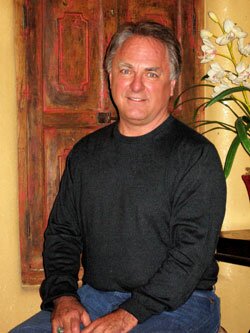
"We still use a Roman-based systems for our water supplies and waste water facilities. That is a centralized system that controls everything, but people forget," says Tom Worrell, "that's what helped kill the Romans."
PHOTO COURTESY TOM WORRELL
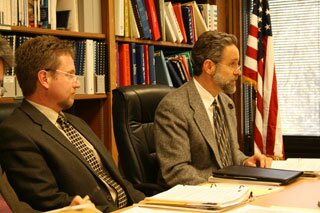
Rivanna Water & Sewer Authority director Tom Frederick (right): "If there were an opportunity where his services matched our need, we would certainly consider the opportunity."
FILE PHOTO BY HAWES SPENCER
GROUPED SHOTS OF LOVELY INSTALLATIONS:

At the Esalen Institute in Northern California, a famous think tank for unconventional thinking, the Living Machine system blends seamlessly into the landscape.
PHOTO COURTESY WORRELL WATER TECHNOLOGIES
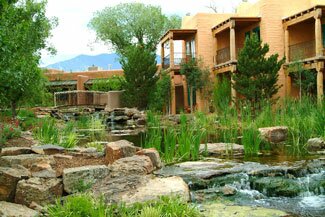
Full circle: The "living river" at Worrell's Taos, New Mexico, luxury resort called El Monte Sagrado is part of a complex stormwater management system that recycles rainwater run off and snow melt to feed the resorts water needs.
PHOTO COURTESY WORRELL WATER TECHNOLOGIES
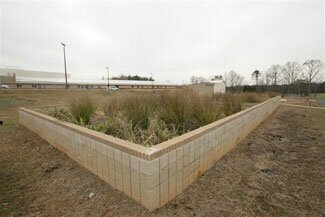
"It's performed really well," says Scott Greene, an environmentalist with the Gilford County Health Department, of the Living Machine that serves two school in North Carolina, "but that's because we have a fantastic operator who monitors it five days a week."
PHOTO COURTESY WORRELL WATER TECHNOLOGIES
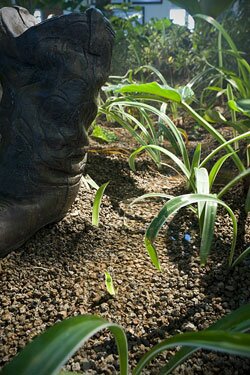
"There's no exposed water surface," says WWT's William Kirksey, "unlike traditional treatment plants, which can cause odor problems, it's all below ground so no odors come out of it."
PHOTO COURTESY WORRELL WATER TECHNOLOGIES
#
7 comments
The Water, Sewer, and Solid Waste Authority has consistently sought the most costly and least sustainable solutions to our local problems. This must stop! Only by citizens voicing their outrage and electing people who do not support this approach will this change.
The current Authority is planning to spend hundreds and hundreds of millions of dollars, potentially as much as 400 million, in the next ten years on new infrastructure for water and sewer. Greg Harper, Water Resource Manager for Albemarle County calls this the "hard path." This destroys what we have and builds all new costly dams, pipes,and old fashioned waste treatment plants. This is the "old school approach" and Charlottesville/Albemarle can and should do better .
Harper, for the water supply and Worrell, for the sewer system are advocating the "soft path", that is the only path, if we hope to sustain the ability of people to pay for these systems and to preserve our resources.
You can help this community save money and the environment by becoming an advocate to adopt the dredging alternative for the water supply and seriously considering Mr. Worrell's approach to our waste needs. It's not too late !
What you can do:
1.Contact Cvillewater.info and go to " WHAT YOU CAN DO " on the home page
2. Contact your elected officials by phone or e-mail
3. Come to meetings of the elected officials to speak . There is a public comment period before all meetings the schedule for these meetings is at charlottesvilletomorrow.org
4. Elect or Re-Elect individuals that do not support the oversized and overpriced water plan or the hard path of all new infrastructure for our water and sewer system, rather than maintaining what we have combined with conservation.
5. Read Greg Harper's paper and material published at our website to learn more
http://readthehook.com/blog/index.php/2008/11/24/pumped-up-county-wa...
WE NEED YOUR HELP TO STOP THIS WASTE OF CITIZEN DOLLARS AND RESOURCES
Cvillewater.info
Good article, but you COULD HAVE GONE ALL WEEK without the 'Poo' Pun for a title.
The data about overflow incidents in this article is truly disturbing and whose to say that after spending 40 million this problem will be solved. From the heavy rains we've been having bet the overflows have continued. Time to explore this concept for Charlottesville. Thanks for the article. Hope our officials are reading this and re-considering their current plan.
As someone who likes to paddle and fish the Rivanna, I'm appalled that there is untreated sewage going into the river at any point in time -- heavy rainfall or not. I had no idea that happened anywhere in the US and certainly not locally.
as for the technology mentioned, I really like the idea of making individual developments responsible for handling their waste in a self-sustained, but I do have concerns about the high percentage capture and re-use of the water in the Taos development mentioned in the article. Too much of that could have a very negative effect on the surrounding groundwater as well as downstream water users.
Too bad modern technology was not explored during the planning process for Albemarle Place. Now, we are headed down the expensive road of retrofitting and replacing. If Chalbemarle wishes to get with the cutting edge, it's going to have to get rid of the elderly people in charge and let the water and sewer and solid waste community know that we are open for business.
Truly innovative ideas would also be more attractive for federal stimulus money. Anyone who would refer to the $40 million plant upgrade as " innovative " is completely out of touch with current technology.
I like the thought that the ecology is going to remove the pollutants. I think that is what is currently going on though. The waste water treatment plants separate the water from the solids. The pollutant (nutrient) rich solids are then trucked to farms and used to grow plants. Those plants are then processed into fuel, food, and fiber. The food portion becomes wastewater again and the cycle repeats again and again. Lisa Williams sucks biosolids gasses and proves that the process is healthy.